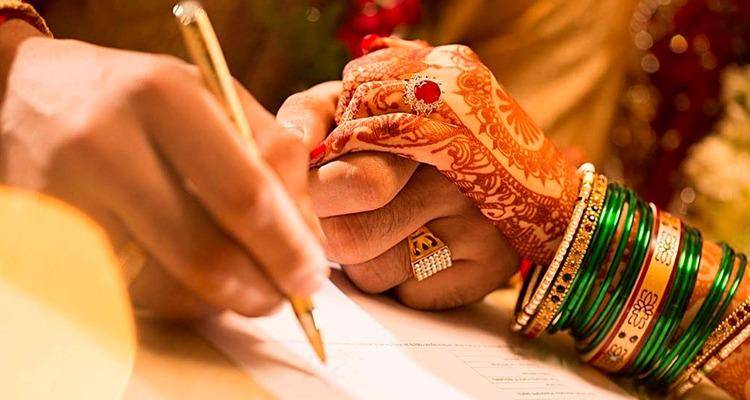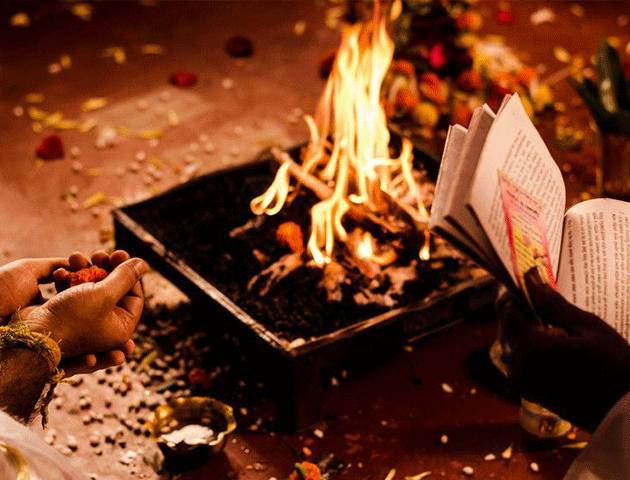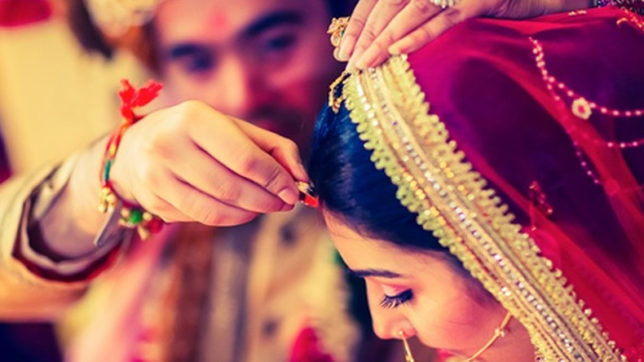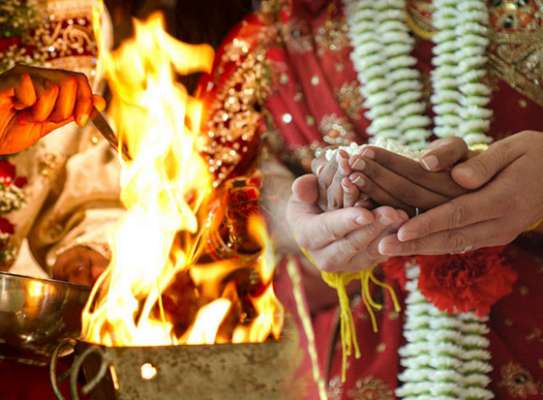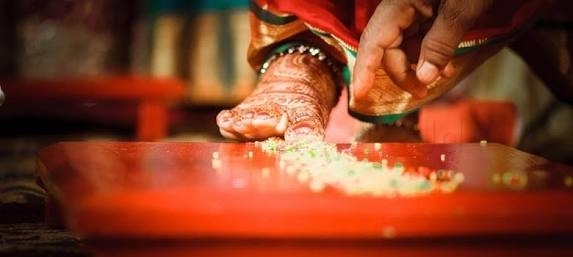Arya Samaj Marriage
Arya Samaj marriages are very simple to execute and the rituals are straight. Couples from different religions who fall under the broad umbrella of Hindus in India can perform Arya Samaj. This is a choice and wiling preference for couples where one person belongs to Buddhism, Jainism or Sikh religion. The ceremony performs adhering to the Vedic rituals in an Arya Samaj temple. According to the Vedic principles, the hymns spelt during the ceremony are explained to the bride and groom. Arya Samaj marriage is just like Hindu marriage, where the marriage takes place around the fire. Also, it is legally recognised. In fact, there is the Arya Samaj Marriage Validation Act of 1937 provided under the Hindu Marriage Act, 1955.
Documents required for solemnization of Arya Samaj Marriage
- PHOTO – Passport Size 6 colored photograph of both Bride and Groom.
- AGE PROOF – Birth Certificate or 10th class mark sheet/certificate or PAN Card or Passport or Driving licence. (any one of the Above Documents of both bride & groom )
- ADDRESS PROOF – Aadhar Card or Passport or Voter ID Card or Driving licence or Bank Passbook ((any one of the Above Documents of both bride & groom )
- WITNESSES- Two Witnesses are required to be present at the time of holy ceremony. Both Witnesses ( Both should be above age of 18 ) with their ID & Address proof (Aadhar Card / Passport / Voter Card / Driving Licence) , & 2 passport size photograph.
- In case where a marrying person is divorced, then, certified copy of divorce certificate issued by the court.
- In case where a marrying person is a widow, the death certificate of the dead spouse.
- Where a marrying person is a foreign citizen or holding a foreign passport or is having foreign residential address- Certificate of present marital status of the party/No Impediment Certificate/ NOC from concerned Embassy and Valid VISA
Eligibility for Arya Samaj Marriage
According to Section 5 in The Hindu Marriage Act, 1955 Conditions for a Hindu marriage. A marriage may be solemnized between any two Hindus, if the following conditions are fulfilled, namely:
(i) neither party has a spouse living at the time of the marriage;
[(ii) at the time of the marriage, neither party (a) is incapable of giving a valid consent to it in consequence of unsoundness of mind; or (b) though capable of giving a valid consent, has been suffering from mental disorder of such a kind or to such an extent as to be unfit for marriage and the procreation of children;
(iii) the bridegroom has completed the age of 21 years [twenty-one years] and the bride, the age of 18 years [eighteen years] at the time of the marriage;
(iv) the parties are not within the degrees of prohibited relationship unless the custom or usage governing each of them permits of a marriage between the two;
(v) the parties are not Sapindas of each other, unless the custom or usage governing each of them permits of a marriage between the two;
Any person who is Hindus, Buddhists, Jains, Sikhs can perform Arya Samaj Marriage.
Arya Samaj Rituals
The Arya Samaj Weddings may not have the long list of traditional hindu rituals but Arya Samaj Weddings do a unique set of rituals that are performed with a lot of passion and enthusiasm. As they don’t believe in Idol worship, Arya Samaj Mandir Marriage by chanting Vedic mantras in the presence of fire and other elements that are witnesses to the wedding. Based on Vedic principles, the mantras that are chanted during the ceremony are translated into a language understandable to the couple. This is done so that the couple can relate to the meaning and significance of the mantras and apply them to their married life.
Arya Samaj Mandir Weddings are different from the traditional Hindu wedding as it does not involve extravagant rituals and the ceremony is relatively short. The wedding ceremony last for an hour and the expenses made at the wedding, compared to a traditional hindu wedding, is minimal. As a matter of fact, there are no pre-wedding functions.
1. Madhuparkaa
To symbolize a happy and prosperous married life, the first Arya Samaj Wedding ritual to take place at the arrival of the bride and groom is enchantment of the holy Vedic hymns and its explanation by Pandit Ji. Then comes the garland exchange ritual, where, the bride garlands the groom first. ‘Madhuparka’ is a mixture of honey, curds and cream. The ritual starts with the bride giving the groom water three times, which he then sprinkles on his feet, over his body and drinks it on the third time. Similarly, the groom then repeats the same ritual three times and then after offering the mixture to the almighty God, the groom eats the Prasadam.

2. Yagna and Kanyadaan
In this Arya Samaj Wedding ritual, Yagna begins with the groom wearing a sacred thread. Then Kanyadaan is the ritual of the father of the bride placing his daughter’s hand in the hands of the groom. This ritual symbolizes that the father henceforth hands the responsibilities of his daughter to her husband.

3. Havan
In Arya Samaj Weddings, as they do not believe in idol worship, the fire burning at the center of the mandap, serves as the holy witness. The pujari or gurukul, brings along the elements that are needed for performing the wedding rites.

4. Pani Grahan Sanskar
The Bride and the Groom perform this ritual together by holding hands and chanting mantras promising to love and care for each other and their needs, throughout their lives. After this, the bride and the groom together, take one ‘parikrama’ around the holy fire.

5. Shilarohan
In this Arya Samaj Wedding ritual, the brides mother other places the brides right foot on a stone while the groom chants mantras given by the pandit. The symbolism of this ritual specifies a strong and solid relation between the bride and the groom, just like the rock. This ritual also represents a prayer made by the couple to strengthen their relation so that together they can face life’s challenges and temptations.

6. Lajahom
The ritual that follows Shilarohan is Lajahom. This ritual consists of offering Murmura or puffed rice into the agni. Here, the bride and groom place their hand in hands and the brother of the bride pours puffed rice into them which is then offered into the holy fire.

7. Phere or Parikrama
After performing all the above rituals the bride and groom now have to take 4 rounds around the agni or holy fire. The end of the bride’s sari and grooms ‘angavastra’ is tied in three knots by the groom’s sister and the phere are witnessed by the holy fire.

8. Saptapadi and Hriday Sparsh Mantra
After the phere, seven steps or ‘Saptapadi’ are taken by the couple followed by one circle around the fire. Here, the couple walk along side, hand in hand. The bride and groom also perform the Hriday Sparsh mantra ritual. Here the couple touch each other’s hearts and promise to be loyal to each other.

9. Sindoor and Mangalsutra
The final ritual is for the groom to apply sindoor on the rides forehead and also tie a mangalsutra around her neck. They feed each other sweets and promise to henceforth care and cherish each other. The arya samaj wedding ends with the couple where the newly-weds view the Dhruv or the Pole Star and then take blessings from the elders.

So that’s it, Everything you need to know about Arya Samaj Marriage Procedures. The rituals of an Arya Samaj marriage might be lesser compared to the traditional Hindu wedding, but it’s just as beautiful and captivating.
Wedding Ceremony


